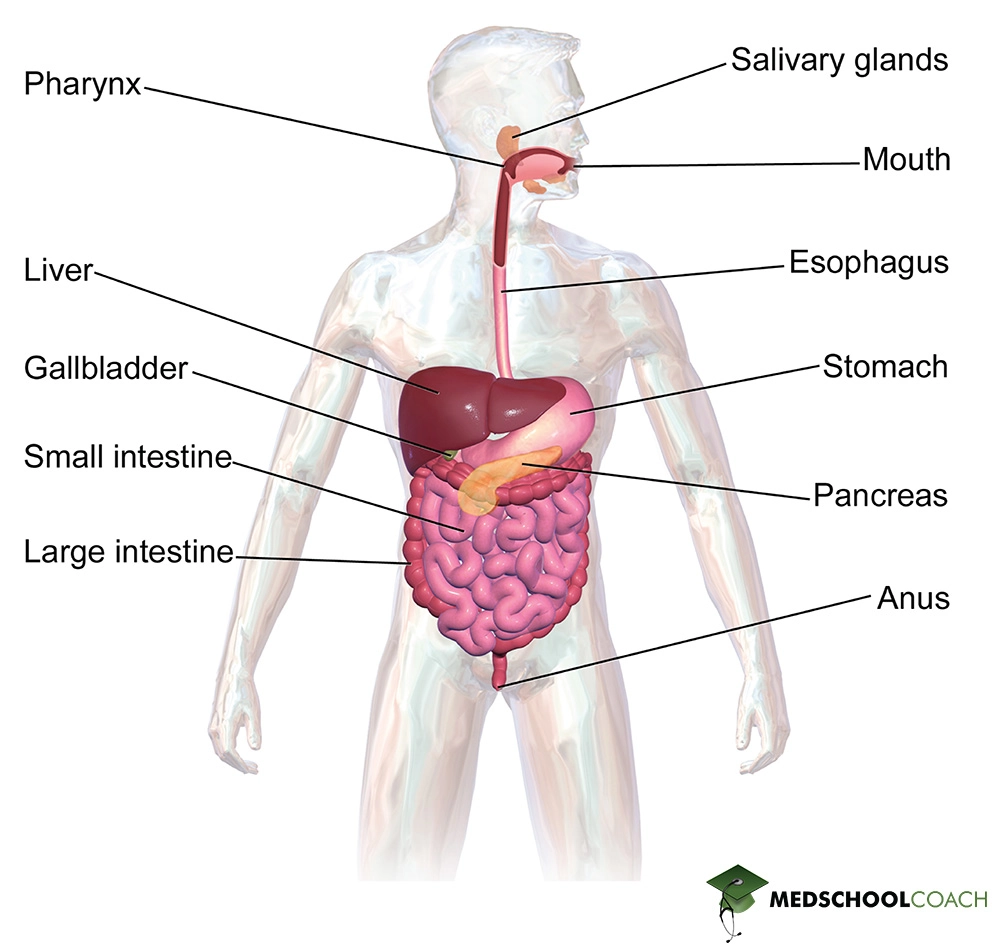Digestive System Anatomy & Function
MCAT Biology - Chapter 7 - Section 6.1 - Organ Systems - Digestive System
- Home
- »
- MCAT Masterclass
- »
- Biological and Biochemical Foundations of Living Systems
- »
- Biology
- »
- Digestive System Anatomy & Function – MCAT Biology
Sample MCAT Question - Digestive System Anatomy & Function
Which of the following is not a function of the pancreas?
a) Produce insulin
b) Produce glucagon
c) Release digestive enzymes
d) Release bile
D is correct. Release bile. The pancreas has both endocrine and exocrine functions. Its endocrine functions include the production of both insulin and glucagon which serve to regulate blood glucose levels (choices A and B are incorrect). Its exocrine function is to release digestive juices that contain digestive enzymes (choice C is incorrect). The enzymes are released into the small intestine to aid in the breakdown of food molecules.
Get 1-on-1 MCAT Tutoring From a Specialist
With MCAT tutoring from MedSchoolCoach, we are committed to help you prepare, excel, and optimize your ideal score on the MCAT exam.
For each student we work with, we learn about their learning style, content knowledge, and goals. We match them with the most suitable tutor and conduct online sessions that make them feel as if they are in the classroom. Each session is recorded, plus with access to whiteboard notes. We focus on high-yield topics if you’re pressed for time. If you have more time or high-score goals, we meticulously cover the entire MCAT syllabus.
Basic Function of the Digestive System
The general purpose of the human digestive system is to break down food particles for absorption. There are several ways the digestive system accomplishes this task. First, it mixes and reduces the size of ingested food through mechanical processes. Second, it secretes compounds and enzymes that help break down food and aid in the absorption of water. Lastly, it absorbs nutrients, electrolytes, and water directly from the intestinal lumen into the bloodstream.
Anatomy of the Digestive System
Figure 1 shows the anatomy of the digestive system. There are two main components – the alimentary canal, also called the gastrointestinal (GI) tract and the accessory organs. The GI tract is a tube that carries food throughout the body for digestion and absorption. It starts with the mouth and progresses to the esophagus, stomach, small intestines, large intestines, and ends with the anus.
The other digestive system component, the accessory organs, secrete compounds that aid in the digestion of food particles. These organs include the salivary glands, liver, pancreas, and gallbladder. The salivary glands produce saliva, which contains enzymes and proteins that start the chemical digestion process. The liver has many functions, including the production of bile, detoxification of harmful substances, the storage of glycogen, and gluconeogenesis. The pancreas has both exocrine and endocrine functions. The endocrine role of the pancreas is to produce the hormones insulin and glucagon, in order to regulate blood glucose concentrations. The exocrine role of the pancreas is to release digestive juices, including enzymes that break down molecules for absorption. Lastly, the gallbladder functions to store and release bile for digestion.

Explore More MCAT Masterclass Chapters
Take a closer look at our entire MCAT Masterclass or explore our Biochemistry lessons below.

One-on-One Tutoring
Are you ready to take your MCAT performance to a whole new level? Work with our 99th-percentile MCAT tutors to boost your score by 12 points or more!
See if MCAT Tutoring can help me
Talk to our enrollment team about MCAT Tutoring

MCAT Go Audio Course
Engaging audio learning to take your MCAT learning on the go, any time, any where. You'll be on the way to a higher MCAT score no matter where you are. Listen to over 200+ lessons.

MCAT Practice Exams
Practice makes perfect! Our mock exams coupled with thorough explanations and in-depth analytics help students understand exactly where they stand.

MCAT Prep App
Access hundreds of MCAT videos to help you study and raise your exam score. Augment your learning with expert-created flashcards and a question banks.
